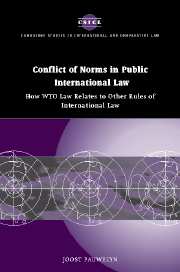 Conflict of Norms in Public International Law
Conflict of Norms in Public International Law Book contents
- Frontmatter
- Contents
- Preface
- Table of cases
- List of abbreviations
- Introduction
- 1 The topic and its importance: conflict of norms in public international law
- 2 The case study: the law of the World Trade Organization
- 3 Hierarchy of sources
- 4 Accumulation and conflict of norms
- 5 Conflict-avoidance techniques
- 6 Resolving ‘inherent normative conflict’
- 7 Resolving ‘conflict in the applicable law’
- 8 Conflict of norms in WTO dispute settlement
- Conclusions
- Bibliography
- Index
- CAMBRIDGE STUDIES IN INTERNATIONAL AND COMPARATIVE LAW
7 - Resolving ‘conflict in the applicable law’
Published online by Cambridge University Press: 07 July 2009
- Frontmatter
- Contents
- Preface
- Table of cases
- List of abbreviations
- Introduction
- 1 The topic and its importance: conflict of norms in public international law
- 2 The case study: the law of the World Trade Organization
- 3 Hierarchy of sources
- 4 Accumulation and conflict of norms
- 5 Conflict-avoidance techniques
- 6 Resolving ‘inherent normative conflict’
- 7 Resolving ‘conflict in the applicable law’
- 8 Conflict of norms in WTO dispute settlement
- Conclusions
- Bibliography
- Index
- CAMBRIDGE STUDIES IN INTERNATIONAL AND COMPARATIVE LAW
Summary
One of the two norms ‘prevails’
In the previous chapter, ‘inherent normative conflict’ was resolved rather categorically by effectively bringing to an end one of the two norms, either through invalidity or termination or through illegality. In most conflicts, however – that is, when faced with what we called ‘conflicts in the applicable law’ – both norms will continue to exist and international law will only offer what one could call ‘priority rules’. In that event, both norms survive the conflict and are considered as valid and ‘legal’. The conflict is then resolved in favour of one of the two rules because that rule has been, or can be, labelled as the more ‘prominent’ or ‘relevant’ one, or because it expresses the latest intention of the parties. The result of these ‘priority rules’ is that only one of the two rules applies to the particular situation at hand.
The initial question is hence not, as under the previous chapter, which of the two norms survives, but which of the two norms applies. In that sense, ‘conflict in the applicable law’ is a question of ‘choice of law’; not one of validity or legality of one norm in the light of another norm.
In terms of state responsibility, under a conflict in the applicable law, obviously, only the rule that must finally be applied can be breached and result in responsibility. The discarded rule does not apply and can hence a fortiori not be breached.
- Type
- Chapter
- Information
- Conflict of Norms in Public International LawHow WTO Law Relates to other Rules of International Law, pp. 327 - 439Publisher: Cambridge University PressPrint publication year: 2003
- 1
- Cited by


